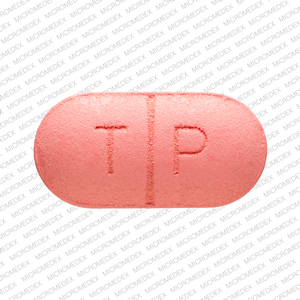Tinidazole Disease Interactions
There are 5 disease interactions with tinidazole.
Nitroimidazoles (applies to tinidazole) blood dyscrasias
Major Potential Hazard, Low plausibility. Applicable conditions: Bone Marrow Depression/Low Blood Counts, History - Blood Dyscrasias
The use of nitroimidazoles (e.g., metronidazole, tinidazole) has rarely been associated with hematologic adverse effects such as mild, transient leukopenia, thrombocytopenia, and bone marrow aplasia. The manufacturers recommend that therapy with nitroimidazoles be administered cautiously in patients with evidence of or a history of blood dyscrasias, and that total and differential leukocyte counts be performed before and after treatment with these drugs, particularly in patients receiving repeated courses of therapy.
References
- Smith JA (1980) "Neutropenia associated with metronidazole therapy." Can Med Assoc J, 123, p. 202
- White CM, Price JJ, Hunt KM (1980) "Bone marrow aplasia associated with metronidazole." Br Med J, 280, p. 647
- (2002) "Product Information. Flagyl (metronidazole)." Searle
- (2004) "Product Information. Tindamax (tinidazole)." Presutti Laboratories Inc
Nitroimidazoles (applies to tinidazole) neurologic toxicity
Major Potential Hazard, Moderate plausibility. Applicable conditions: CNS Disorder, Peripheral Neuropathy
The use of nitroimidazoles (e.g., metronidazole, tinidazole) has been associated with the development of nervous system toxicity including convulsive seizures and dose-related peripheral neuropathy, the latter characterized primarily by numbness or paresthesia of an extremity. Persistent peripheral neuropathy has been reported in some patients treated for prolonged periods. Other neurologic adverse effects include vertigo, incoordination, ataxia, confusion, agitation, hallucinations, and depression. Therapy with nitroimidazoles should be administered cautiously in patients with or predisposed to seizures or other nervous system abnormalities. Nitroimidazole therapy should be discontinued promptly if neurologic disturbances occur.
References
- Kusumi RK, Plouffe JF, Wyatt RH, Fass RJ (1980) "Central nervous sytem toxicity associated with metronidazole therapy." Ann Intern Med, 93, p. 59-60
- Schentag JJ, Ziemniak JA, Greco JM, Rainstein M, Buckley RJ (1982) "Mental confusion in a patient treated with metronidazole: a concentration-related effect." Pharmacotherapy, 2, p. 384-7
- Alvarez RS, Richardson DA, Bent AE, Ostergard DR (1983) "Central nervous system toxicity related to prolonged metronidazole therapy." Am J Obstet Gynecol, 145, p. 640-1
- Wienbren M, Perinpanayagam RM, Camba L, Lee CA (1985) "Convulsions and encephalopathy in a patient with leukaemia after treatment with metronidazole." J Clin Pathol, 38, p. 1076
- Duffy LF, Daum F, Fisher SE, et al. (1985) "Peripheral neuropathy in Crohn's disease patients treated with metronidazole." Gastroenterology, 88, p. 681-4
- Boyce EG, Cookson ET, Bond WS (1990) "Persistent metronidazole-induced peripheral neuropathy." DICP, 24, p. 19-21
- Stahlberg D, Barany F, Einarsson K, Ursing B, Elmquist D, Persson A (1991) "Neurophysiologic studies of patients with Crohn's disease on long-term treatment with metronidazole." Scand J Gastroenterol, 26, p. 219-24
- (2002) "Product Information. Flagyl (metronidazole)." Searle
- Learned-Coughlin S (1994) "Peripheral neuropathy induced by metronidazole." Ann Pharmacother, 28, p. 536
- Lawford R, Sorrell TC (1994) "Amebic abscess of the spleen complicated by metronidazole-induced neurotoxicity: case report." Clin Infect Dis, 19, p. 346-8
- Ahmed A, Laes DJ, Bressler EL (1995) "Reversible magnetic resonance imaging findings in metronidazole-induced encephalopathy." Neurology, 45, p. 588-9
- Schreiber W, Spernal J (1997) "Metronidazole-induced psychotic disorder." Am J Psychiatry, 154, p. 1170-1
- Beloosesky Y, Grosman B, Marmelstein V, Grinblat J (2000) "Convulsions induced by metronidazole treatment for Clostridium difficile-associated disease in chronic renal failure." Am J Med Sci, 319, p. 338-9
- (2004) "Product Information. Tindamax (tinidazole)." Presutti Laboratories Inc
Nitroimidazoles (applies to tinidazole) alcoholism
Moderate Potential Hazard, Moderate plausibility.
Nitroimidazoles (e.g., metronidazole, tinidazole, fexinidazole, secnidazole) may inhibit alcohol dehydrogenase and occasionally precipitate a disulfiram-like reaction in patients who consume alcohol while being treated. Symptoms may include abdominal cramps, nausea, vomiting, headache, flushing, rash, weakness, diarrhea, abdominal pain, dizziness, sweating, and hypotension. Patients should be instructed to avoid alcohol-containing products during nitroimidazole therapy and for at least 48 hours (fexinidazole, secnidazole) to 72 hours (metronidazole, tinidazole) after the last dose. Therapy with nitroimidazoles should be administered cautiously in patients who might be prone to acute alcohol intake. An alternative therapy may be appropriate.
References
- (2002) "Product Information. Flagyl (metronidazole)." Searle
- (2004) "Product Information. Tindamax (tinidazole)." Presutti Laboratories Inc
- (2017) "Product Information. Solosec (secnidazole)." Symbiomix Therapeutics
- (2021) "Product Information. Fexinidazole (fexinidazole)." sanofi-aventis
Tinidazole (applies to tinidazole) hemodialysis
Moderate Potential Hazard, High plausibility.
The clearance of tinidazole is significantly increased during hemodialysis; the half-life is reduced from 12 hours to 4.9 hours. During a 6-hour hemodialysis session, approximately 43% of the amount present in the body is eliminated. If this drug is administered on the same day as and prior to hemodialysis, an additional dose of tinidazole equivalent to one-half the recommended dose should be administered after the end of the hemodialysis session.
References
- (2004) "Product Information. Tindamax (tinidazole)." Presutti Laboratories Inc
Tinidazole (applies to tinidazole) liver disease
Moderate Potential Hazard, Moderate plausibility.
There are no data on the pharmacokinetics of tinidazole in patients with liver dysfunction. Reduced metabolic elimination of metronidazole (a chemically-related nitroimidazole) has been reported in patients with liver dysfunction. Usual recommended doses of tinidazole should be administered cautiously in patients with liver dysfunction.
References
- (2004) "Product Information. Tindamax (tinidazole)." Presutti Laboratories Inc
Tinidazole drug interactions
There are 193 drug interactions with tinidazole.
Tinidazole alcohol/food interactions
There is 1 alcohol/food interaction with tinidazole.
More about tinidazole
- tinidazole consumer information
- Check interactions
- Compare alternatives
- Pricing & coupons
- Reviews (106)
- Drug images
- Side effects
- Dosage information
- During pregnancy
- Drug class: amebicides
- Breastfeeding
- En español
Related treatment guides
Drug Interaction Classification
| Highly clinically significant. Avoid combinations; the risk of the interaction outweighs the benefit. | |
| Moderately clinically significant. Usually avoid combinations; use it only under special circumstances. | |
| Minimally clinically significant. Minimize risk; assess risk and consider an alternative drug, take steps to circumvent the interaction risk and/or institute a monitoring plan. | |
| No interaction information available. |
Further information
Always consult your healthcare provider to ensure the information displayed on this page applies to your personal circumstances.


